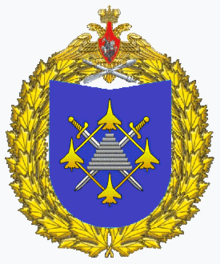Kubinka (air base)
Kubinka (Russian: Кубинка) is an air base in Moscow Oblast, Russia located 5 km northwest of Kubinka. In close proximity to Moscow, the Kubinka facility showcases the best of the Russian Air Force to the general public.
Kubinka Кубинка | |||||||||||
|---|---|---|---|---|---|---|---|---|---|---|---|
 | |||||||||||
| Summary | |||||||||||
| Airport type | Military | ||||||||||
| Operator | Russian Air Force | ||||||||||
| Location | Kubinka, Moscow Oblast | ||||||||||
| Elevation AMSL | 614 ft / 187 m | ||||||||||
| Coordinates | 55°36′42″N 036°39′0″E | ||||||||||
| Runways | |||||||||||
| |||||||||||
The 82nd aviation detachment (separate) arrived at the base in 1935, joined in 1938 by the 11th and 24th Aviation Regiments. Personnel of these units field-tested the advanced Yak-1 and LaGG-3 fighters and defended Moscow during the Second World War. After the war, the base became home to the 324th Svirskaya Fighter Aviation Division from November 1945.[1] In November 1950, the whole 324th Fighter Aviation Division was redeployed to Korea, and the base was taken over by the 9th Fighter Aviation Division from February 1951.[2]
Units which have been stationed at Kubinka include:
- 237th Centre for Display of Aviation Equipment (237 TsPAT) flying MiG-29E, Su-17C, Su-24, Su-25, and Su-27 during the 1990s (with one exception given as 239 TsPAT in Yefim Gordon's Su-24 book.[3]) The regiment, which has inherited the traditions of the 19 OIAP (1938–1944) and the 176 Gv IAP (1944–1950),[4] was formed under the number 234 in November 1950. It arrived at Kubinka at the beginning of 1952. On 15 January 1989 it was renamed the 237th Composite Aviation Regiment (Demonstration) (237 SAP(P)). It became the 237 TsPAT on 13 February 1992 and then gained the title 'named for Air Marshal I.N. Kozhedub' on 10 August 1993.[5]
- 234th Guards Instructional Interceptor Aviation Regiment (234 Gv IIAP) flying MiG-23MLD and MiG-29 aircraft.
- 378th Independent Composite Aviation Squadron (378 OSAE) flying Mil Mi-8 helicopters.
- 29 Gv IAP (during the 1950s).
- 9th Fighter Aviation Division (November 1952 – 1993)
Most units at Kubinka were subordinated up until 2009-2010 to the Special Purpose Command of the Russian Air Force.
The 32nd Guards Fighter Aviation Regiment was based at Kubinka from February 1950 to 1962-63. The regiment was subordinated to the 9th Fighter Aviation Division. It was then reformed at the base after being deployed to Cuba as part of Operation Anadyr.[6] The regiment initially flew MiG-19s but by 1962 was flying MiG-21F-13s. The regiment was still in place in the late 1980s.[7] From 1968 to 1989 it was part of the 9th Fighter Aviation Division, stationed at Shatalovo (air base), Smolensk Oblast. The 32nd Guards Fighter Aviation Regiment was formed in 1941 as the 434th Fighter Aviation Regiment. It became 32nd Guards Fighter Aviation Regiment by an order of the People's Commissariat for Defence (Soviet Defence Ministry, NKO) in November 1942. The regiment was disbanded on 1 July 1989.[8]
References
- Michael Holm, 324th Fighter Aviation Division, accessed November 2011
- Electronicaviation.com, The Russian Knights Archived 2012-03-31 at the Wayback Machine, posted 12-18-2007 at 12:38 AM. See Michael Holm, 9th Fighter Aviation Division, accessed November 2011
- Gordon, Yefim (2003). Sukhoi SU-24 (Russian Aircraft in Action). IP Media and Polygon Press. ISBN 1-932525-01-7.
- See also Michael Holm, 176th Guards Fighter Aviation Regiment, accessed September 2011
- Air Power Analysis: Russian Federation, Part 2, International Air Power Review, AIRTime Publishing, Volume 13, Summer 2004, ISSN 1473-9917, p.88. Note Holm's page at http://www.ww2.dk/new/air%20force/regiment/iap/234gviap.htm disagrees with this information.
- "The 32nd Guards Regiment in Cuba" (in Russian). Airforce.ru. Retrieved 2019-01-26.
- Fes'kov, V.I.; Golikov, V.I.; K.A. Kalashnikov (2004). The Soviet Army In The Years Of The Cold War 1945–1991. Tomsk University Publishing House. pp. 144–145. ISBN 5-7511-1819-7.
- "http://allaces.ru/cgi-bin/s2.cgi/sssr/struct/p/iap434.dat and Holm". ww2.dk. Retrieved 26 January 2019. External link in
|title=(help)